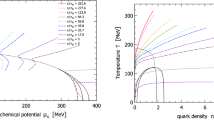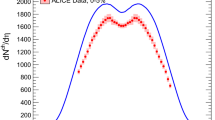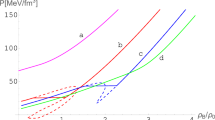Abstract
Using the most advanced formulation of the hadron resonance gas model we analyze the two sets of irregularities found at chemical freeze-out of central nuclear-nuclear collisions at the center of mass energies 3.8–4.9 GeV and 7.6–9.2 GeV. In addition to previously reported irregularities at the collision energies 4.9 and 9.2 GeV we found sharp peaks of baryonic charge density. Also we analyze the collision energy dependence of the modified Wroblewski factor and the strangeness suppression factor. Based on the thermostatic properties of the mixed phase of a 1st order phase transition and the ones of the Hagedorn mass spectrum we explain, respectively, the reason of observed chemical equilibration of strangeness at the collision energy 4.9 GeV and above 8.7 GeV. It is argued that the both sets of irregularities possibly evidence for two phase transitions, namely, the 1st order transition at lower energy range and the 2nd order transition at higher one. In combination with a recent analysis of the light nuclei number fluctuations we conclude that the center of mass collision energy range 8.8–9.2 GeV may be in the nearest vicinity of the QCD tricritical endpoint. The properties of the phase existing between two phase transitions are revealed and discussed.
Similar content being viewed by others
References
M. Stephanov, K. Rajagopal, and E. Shuryak, “Eventby-event fluctuations in heavy ion collisions and the QCD critical point,” Phys. Rev. D: Part. Fields 60, 114028–1–32 (1999).
NICA White Paper, V. 9.01 (2013).
R. Lacey, “Indications for a critical end point in the phase diagram for hot and dense nuclear matter,” Phys. Rev. Lett. 114, 142301 (2015).
N. G. Antoniou, N. Davis, and F. K. Diakonos, “What is the gamma gamma resonance at 750 GeV?” arXiv:1607.01326v1 [nucl-th] (2016).
M. Ladrem and A. Ait-El-Djoudi, “Finite-size effects and scaling for the thermal QCD deconfinementphase transition within the exact color-singlet partition function,” Eur. Phys. J. C 44, 257–265 (2005).
K. A. Bugaev, A. I. Ivanytskyi, D. R. Oliinychenko, V.V. Sagun, I. N. Mishustin, D. H. Rischke, L. M. Satarov, and G. M. Zinovjev, “Thermodynamically anomalous regions as a mixed phase signal,” Phys. Part. Nucl. Lett. 12, 238–245 (2015); arXiv:1405.3575.
K. A. Bugaev, A. I. Ivanytskyi, D. R. Oliinychenko, V.V. Sagun, I. N. Mishustin, D. H. Rischke, L. M. Satarov, and G. M. Zinovjev, “Thermodynamically anomalous regions and possible new signals of mixed-phase formation,” Eur. Phys. J. A 52 (6), 175 (2016); arXiv:1412.0718.
K. A. Bugaev, D. R. Oliinychenko, J. Cleymans, A. I. Ivanytskyi, I. N. Mishustin, E. G. Nikonov, and V. V. Sagun, “Chemical freeze-out of strange particles and possible root of strangeness suppression,” Europhys. Lett. 104, 22002 (2013).
V. V. Sagun, “Anomaly in the hadronic chemical freeze-out,” Ukr. J. Phys. 59, 755–763 (2014).
K. A. Bugaev, V. V. Sagun, A. I. Ivanytskyi, D. R. Oliinychenko, E. -M. Ilgenfritz, E. G. Nikonov, A. V. Taranenko, and G. M. Zinovjev, “New signals of quark-gluon-hadron mixed phase formation,” Eur. Phys. J. A 52, 227 (2016); arXiv:1510.03099.
K. A. Bugaev, M. I. Gorenstein, B. Kämpfer, and V. I. Zhdanov, “Generalized shock adiabatics and relativistic nuclear collisions,” Phys. Rev. D: Part. Fields 40, 2903 (1989).
K. A. Bugaev, M. I. Gorenstein, and D. H. Rischke, “Pion multiplicity in heavy-ion collisions: possible signature of the deconfinement transition,” Phys. Lett. B 255, 18 (1991).
Kai-Jia Sun, Lie-Wen Chen, Che Ming Ko, and Zhangbu Xu, “Probing QCD critical fluctuations from light nuclei production in relativistic heavy-ion collisions,” arXiv:1702.07620v1 [nucl-th] (2017).
K. A. Bugaev, V. V. Sagun, A. I. Ivanytskyi, I. P. Yakimenko, E. G. Nikonov, A. V. Taranenko, and G. M. Zinovjev, “Hadron resonance gas model for an arbitrarily large number of different hard-core radii,” arXiv:1611.07349v2 [nucl-th] (2016).
V. V. Sagun, K. A. Bugaev, A. I. Ivanytskyi, I. P. Yakimenko, E. G. Nikonov, A. V. Taranenko, C. Greiner, D. B. Blaschke, and G. M. Zinovjev, “Hadron resonance gas model with induced surface tension,” arXiv:1703.00049 [nucl-th] (2017).
K. A. Bugaev, A. I. Ivanytskyi, V. V. Sagun, E. G. Nikonov, and G. M. Zinovjev, “Equation of state of quantum gases beyond the van der waals approximation,” arXiv:1704.06846 [nucl-th] (2017).
A. Andronic, P. Braun-Munzinger, and J. Stachel, “Hadron production in central nucleus-nucleus collisions at chemical freeze-out,” Nucl. Phys. A 722, 167 (2006).
K. A. Bugaev, D. R. Oliinychenko, A. S. Sorin, and G. M. Zinovjev, “Simple solution to the strangeness horn description puzzle,” Eur. Phys. J. A 49, 30 (2013).
D. H. Rischke, M. I. Gorenstein, H. Stocker, and W. Greiner, “Excluded volume effect for the nuclear matter equation of state,” Z. Phys. C 51, 485 (1991).
N. F. Carnahan and K. E. Starlin, “Equation of state for nonattracting rigid spheres,” J. Chem. Phys. 51, 635 (1969).
G. A. Mansoori, N. F. Carnahan, K. E. Starling, and T. W. Leland, Jr., “Equation of state for nonattracting rigid spheres,” J. Chem. Phys. 54, 1523 (1971).
J. P. Hansen and I. R. McDonald, Theory of Simple Liquids (London, Academic, 2006).
J. J. Salacuse and G. Stell, “Polydisperse systems: statistical thermodynamics, with applications to several models including hard and permeable spheres,” J. Chem. Phys. 77, 3714 (1982).
J. L. Klay et al. (E895 Collab.), “Charged pion production in 2A to 8A GeV central Au + Au collisions,” Phys. Rev. C 68, 054905 (2003).
L. Ahle et al. (E866 Collab.), “Excitation function of K+ and Π+ production in Au + Au reactions at 2–10 A GeV,” Phys. Lett. B 476, 1 (2000).
L. Ahle et al. (E866 Collab.), “An excitation function of and production in Au+Au reactions at the AGS,” Phys. Lett. B 490, 53 (2000).
C. Pinkenburg et al. (E895 Collab.), “Production and collective behavior of strange particles in Au + Au collisions at 2–8 A GeV,” Nucl. Phys. A 698, 495 (2002).
J. Barrette et al. (E877 Collab.), “Proton and pion production in Au+Au collisions at 10.8 AGeV/c,” Phys. Rev. C 62, 024901 (2000).
L. Ahle et al. (E802 Collab.), “Proton and deuteron production in Au+Au reactions at 11.6 AGeV/c,” Phys. Rev. C 60, 064901 (1999).
L. Ahle et al. (E802 Collab.), “Kaon production in Au+Au collisions at 11.6 AGeV/c,” Phys. Rev. C 58, 3523 (1998).
S. Albergo et al., “Spectra in 11.6 AGeV/c Au–Au collisions,” Phys. Rev. Lett. 88, 062301 (2002).
B. B. Back et al. (PHOBOS Collab.), “Ratios of charged antiparticles-to-particles near mid-rapidity in Au+Au collisions at \(\sqrt {{s_{NN}}} \)= 130 GeVs,” Phys. Rev. Lett. 87, 102301 (2001).
I. G. Bearden et al. (NA44 Collab.), “Particle production in central Pb + Pb collisions at 158 AGeV/c,” Phys. Rev. C 66, 044907 (2002).
S. V. Afanasiev et al. (NA49 Collab.), “Energy dependence of pion and kaon production in central Pb + Pb collisions,” Phys. Rev. C 66, 054902 (2002).
S. V. Afanasiev et al. (NA49 Collab.), “Energy and centrality dependence of deuteron and proton production in Pb + Pb collisions at relativistic energies,” Phys. Rev. C 69, 024902 (2004).
C. Alt et al. (NA49 Collab.), “Energy and centrality dependence of anti-p and p production and the antilambda/anti-p ratio in Pb + Pb collisions between 20/A-GeV and 158/A-Gev,” Phys. Rev. C 73, 044910 (2006).
T. Anticic et al. (NA49 Collab.), “Λ and \(\bar \wedge \) production in central Pb–Pb collisions at 40, 80, and 158 AGeV,” Phys. Rev. Lett. 93, 022302 (2004).
S. V. Afanasiev et al. (NA49 Collab/), “Ξ- and Ξ+ production in central Pb+Pb collisions at 158 GeV/c per nucleon,” Phys. Rev. B 538, 275 (2002).
C. Alt et al. (NA49 Collab.), “Ω– and Ω+ production in central Pb + Pb collisions at 40 and 158 AGeV,” Phys. Rev. Lett. 94, 192301 (2005).
F. Antinori et al. (NA57 Collab.), “Energy dependence of hyperon production in nucleus-nucleus collisions at SPS,” Phys. Lett. B 595, 68 (2004).
F. Antinori et al. (NA57 Collab.), “Rapidity distributions around mid-rapidity of strange particles in Pb–Pb collisions at 158 A GeV/C,” J. Phys. G 31, 1345 (2005).
J. Adams et al. (STAR Collab.), “Identified particle distributions in pp and Au + Au collisions at \(\sqrt {{s_{NN}}} \)= 200 GeV,” Phys. Rev. Lett. 92, 112301 (2004).
K. A. Bugaev, M. I. Gorenstein, H. Stocker, and W. Greiner, “Van der Waals excluded volume model for Lorentz contracted rigid spheres,” Phys. Lett. B 485, 121 (2000).
K. A. Bugaev, “Van-der-Waals gas EOS for the Lorentz contracted spheres,” Nucl. Phys. A 807, 251 (2008).
A. K. Wroblewski, “On the strange quark suppression factor in high energy collisions,” Acta Phys. Polon. B 16, 379 (1985).
J. Rafelski, “Strange anti-baryons from quark-gluon plasma,” Phys. Lett. B 262, 333 (1991).
K. A. Bugaev, D. R. Oliinychenko, A. I. Ivanytskyi, J. Cleymans, E. S. Mironchuk, E. G. Nikonov, A. V. Taranenko, and G. M. Zinovjev, “Separate chemical freeze-outs of strange and non-strange hadrons and problem of residual chemical non-equilibrium of strangeness in relativistic heavy ion collisions,” Ukr. J. Phys. 61, 659 (2016).
R. Hagedorn, “Statistical thermodynamics of strong interactions at high energies,” Nuovo Cimento Suppl. 3, 147 (1965).
L. G. Moretto, K. A. Bugaev, J. B. Elliott, and L. Phair, “Hagedorn thermostat,” Europhys. Lett. 76, 402 (2006).
M. Beitel, K. Gallmeister, and C. Greiner, “Thermalization of hadrons via hagedorn states,” Phys. Rev. C 90, 045203 (2014); arXiv:1402.1458.
M. Beitel, K. Gallmeister, and C. Greiner, “Equilibration of hadrons in HICs via hagedorn states,” J. Phys.: Conf. Ser. 668, 012057 (2016).
M. Beitel, C. Greiner, and H. Stoecker, “Fast dynamical evolution of a hadron resonance gas via hagedorn states,” Phys. Rev. C 94, 021902 (2016).
J. K. Nayak, S. Banik, and J. Alam, “The “horn” in the kaon-to-pion ratio,” Phys. Rev. C 82, 024914 (2010).
V. M. Galitskij and I. N. Mishustin, “The influence of a phase transition on the shock wave dynamics in nuclear matter,” Phys. Lett. B 72, 285 (1978).
H. Stöcker, G. Graebner, J. A. Maruhn, and W. Greiner, “Hot, dense hadronic and quark matter in relativistic nuclear collisions,” Phys. Lett. B 95, 192 (1980).
B. Kämpfer, “Phase transitions in dense nuclear matter and consequences for neutron stars,” J. Phys. G 9, 1487 (1983).
H. Stöcker and W. Greiner, “High energy heavy ion collisions: probing the equation of state of highly excited hardronic matter,” Phys. Rep. 137, 277 (1986).
H. W. Barz, L. P. Csernai, B. Kämpfer, and B. Lukacs, “Stability of detonation fronts leading to quark-gluon plasma,” Phys. Rev. D: Part. Fields 32, 115 (1985).
A. V. Merdeev, L. M. Satarov, and I. N. Mishustin, “Hydrodynamic modeling of the deconfinement phase transition in heavy-ion collisions in the NICA-FAIR energy domain,” Phys. Rev. C 84, 014907 (2011).
Yu. B. Ivanov, V. N. Russkikh, and V. D. Toneev, “Relativistic heavy-ion collisions within three-fluid hydrodynamics: hadronic scenario,” Phys. Rev. C 73, 044904 (2006).
L. D. Landau and E. M. Lifshitz, Fluid Mechanics (Pergamon, New York, 1979; Academic, New York, 1967).
Y. B. Zel’dovich and Y. P. Raiser, Physics of Shock Waves and High Temperature Hydrodynamic Phenomena (Academic, New York, 1967).
B. L. Rozhdestvensky and N. N. Yanenko, Systems of Quasi-Linear Equations (Nauka, Moscow, 1978) [in Russian].
A. Chodos et al., “New extended model of hadrons,” Phys. Rev. D: Part. Fields 9, 3471 (1974).
Y. Aoki et al., “The QCD transition temperature: results with physical masses in the continuum limit,” Phys. Lett. B 643, 46 (2006).
S. A. Chin, “Transition to hot quark matter in relativistic heavy-ion collision,” Phys. Lett. B 78, 552 (1978).
Particle Data Group, Phys. Lett. B 591, 1 (2004).
W. Cassing, A. Palmese, P. Moreau, and E. L. Bratkovskaya, “Chiral symmetry restoration versus deconfinement in heavy-ion collisions at high baryon density,” Phys. Rev. C 93, 014902 (2016).
A. Palmese et al., “Chiral symmetry restoration in heavy-ion collisions at intermediate energies,” Phys. Rev. C 94, 044912 (2016).
N. K. Glendenning, “Hot metastable state of abnormal matter in relativistic nuclear field theory,” Nucl. Phys. A 469, 600 (1987).
S. I. A. Garpman, N. K. Glendenning, and Y. J. Karant, “Thermodynamic behavior of non-strange baryonic matter,” Nucl. Phys. A 322, 382 (1979).
J. Theis et al., “Phase transition of the nucleon-antinucleon plasma in a relativistic mean-field theory,” Phys. Rev. D: Part. Fields 28, 2286 (1983).
T. Nakai and S. Takagi, “Influence of the N*(1470) to density isomer and a phase transition of the baryonantibaryon plasma at finite temperatures,” Prog. Theor. Phys. 71, 1118 (1984).
R. D. Pisarski and V. V. Skokov, “How tetraquarks can generate a second chiral phase transition,” Phys. Rev. D: Part. Fields 94, 054008 (2016).
A. Andronic et al., “Hadron production in ultra-relativistic nuclear collisions: quarkyonic matter and a triple point in the phase diagram of QCD,” Nucl. Phys. A 837, 65 (2010).
J. M. Lattimer and F. D. Swesty, “A generalized equation of state for hot, dense matter,” Nucl. Phys. A 535, 331 (1991).
L. H. Shen, H. Toki, K. Oyamatsu, and K. Sumiyoshi, “Relativistic equation of state of nuclear matter for supernova and neutron star,” Nucl. Phys. A 637, 435 (1998).
S. Typel, “Variations on the excluded-volume mechanism,” Eur. Phys. J. A 52, 16 (2016).
Author information
Authors and Affiliations
Corresponding author
Additional information
The article is published in the original.
Rights and permissions
About this article
Cite this article
Bugaev, K.A., Emaus, R., Sagun, V.V. et al. Threshold Collision Energy of the QCD Phase Diagram Tricritical Endpoint. Phys. Part. Nuclei Lett. 15, 210–224 (2018). https://doi.org/10.1134/S1547477118030068
Received:
Published:
Issue Date:
DOI: https://doi.org/10.1134/S1547477118030068




